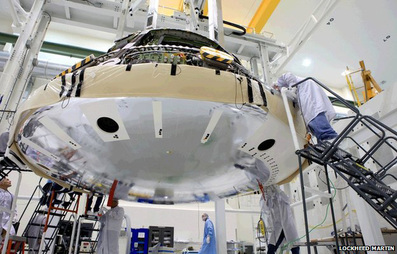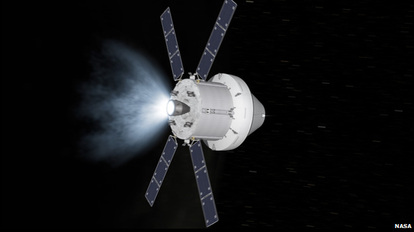 The Orion capsule, the Space Shuttle replacement.
The Orion capsule, the Space Shuttle replacement. Clearly, when you look at the vehicle, it closely resembles the manned capsule of the Apollo era and this ‘next generation’ seems at first thought to be a retrograde step. However, Orion is about twice the size of the Apollo capsule and can accommodate 4 astronauts in reasonable comfort. Another advantage is of course that its design integrates the latest technology into the system. But its main benefit is safety – a lesson learned from the shuttle era. In the 30 years of Shuttle operation the US human spaceflight programme achieved a great many spectacular successes, but it also saw some tragic lows with loss of 2 crews in 1986 and 2003. The issue was the Shuttle’s complexity – although this allowed great flexibility in mission capability, it also made the vehicle dangerous. This was primarily because it had no genuine escape system for the crew.
Taking onboard these issues, the system designers of Orion have gone for relative simplicity in order to improve crew safety. The final launch vehicle for the Orion spacecraft – which is yet to be developed – will have a simple multi-stage configuration with an escape tower system to drag the manned capsule clear in the event of a catastrophic launch failure. Also the heat shield configuration of Orion is simpler than Shuttle, and protected from debris impact risk on launch, so reducing risk on re-entry into the atmosphere. So the philosophy is to launch people on a ‘simple’ and very reliable expendable launch vehicle, and launch the required hardware for the particular mission separately on a relatively less-reliable heavy lift launcher – the two component parts coming together and docking in orbit afterwards.
Coming back to yesterday’s test, the Orion vehicle was launched at 12.05 UT atop a (stand in) Delta 4 heavy lift expendable launch vehicle (see video).
 The Orion capsule/service module configuration.
The Orion capsule/service module configuration.  RSS Feed
RSS Feed
